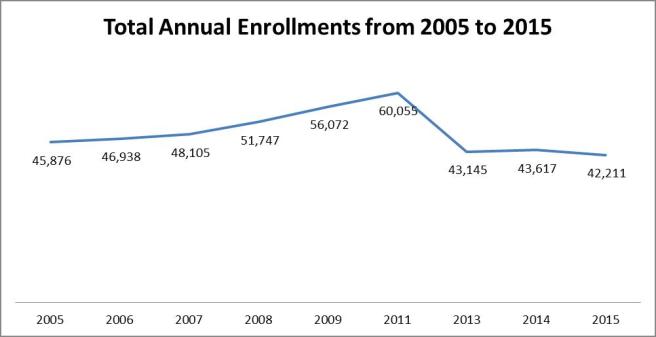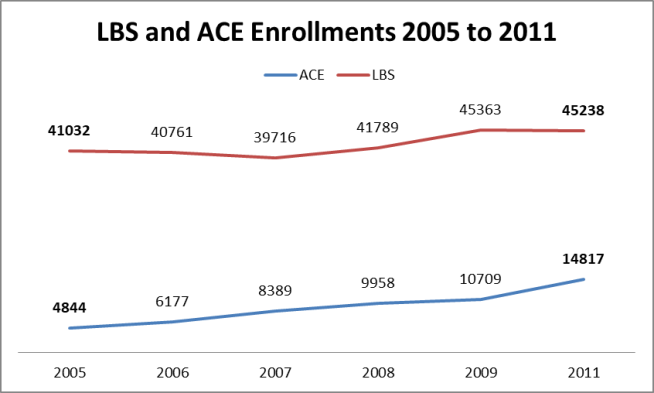I was planning to write more about the LBS force-fit into Employment Ontario but then more details about the infusion of funding into LBS were released and I got a little distracted by $85 million in exchange for 80,000 new students.
Last Friday the minister for Advanced Education and Skills Development announced a substantial funding increase for Literacy and Basic Skills (LBS). At the end of four years, LBS funding will increase to $185 million.* Also at the end of the four years 80,000 additional learners will access the program, an average of 20,000 new learners per year. Programs currently see a total of 42,000 learners per year. That means they may have to increase total enrollments to about 62,000 per year on average.
To hear of a funding increase in Ontario when other provinces and the US are battling decreases is a relief. Adult learners in British Columbia who need to upgrade or gain pre-requisites for college must now pay tuition. Newfoundland and Labrador privatized its college-based high school equivalency program for adults a few years ago, leading to increased costs, along with a drop in graduation and enrollments. Adult literacy, language and GED programs in the United States are currently facing a 16% cut in federal funding.
While the funding is seemingly good news, programs may start to feel differently as details are worked out. The $85 million in exchange for 80,000 new learners is a daunting commitment.
In addition, there is not (yet?) any talk of increasing the per student amount for even larger players in Ontario’s adult learning system: English/French as a Second Language, funded by the Ministry of Citizenship and Immigration and adult secondary credit, funded by the Ministry of Education. Maybe one day adult learning outside the postsecondary system will be seen as a fundamental part of a comprehensive education system, and not simply an afterthought.
Getting learners online
The ministry also seems to have a plan to use the funding to support e-learning and digital literacy. Digital literacy and learning are mentioned in various ways in a memo that outlines how some of the initial funding increases will be used:
- across-the-board increases for all LBS service delivery sites, e-Channel service providers, support organizations, and regional networks
- an increase in learners served, including serving learners in high-demand communities, and through e-channel
- improvements to digital capacity and IT equipment across the LBS network
- the launch of innovative literacy and essential skills training pilots to reach more learners.
One could assume that the proposed “innovative literacy and essential skills training pilots” will involve digital literacy development and/or online learning.
Also, the new funding is not equitably allocated over the four years. This seems to suggest that there may be a development phase followed by an implementation phase.
| Cumulative Funding | Annual Increase | |
| Year 1 | $20 million | $20 million |
| Year 2 | $25 million | $ 5 million |
| Year 3 | $55 million | $30 million |
| Year 4 | $85 million | $30 million |
| TOTAL | $85 million |
Year 1 funding will be used to build organizational capacity and develop new online learning approaches and potential pilots.
Year 2 funding will likely be used to evaluate and further develop the new approaches.
Funding in Years 3 and 4 will be used to implement the new models and target new learners.
If this is the case, and it is only speculation on my part at this point, it means that programs will have to attract most new learners in the final two years, doubling their numbers in each of those years. Of course, it is also very possible that not all programs will be directly involved in this effort.
The last time there was new funding and an enrollment increase
It may be useful to go back a few years to look at a previous funding infusion accompanied by enrollment increases—that was short-lived—to figure out what can be learned and what supports will be needed to reach so many new learners in such a short period of time.

Notes on graph: Dates represent the start of each fiscal year so 2005 is 2005-2006. I don’t have raw data for 2010 and data for 2011 came from a document completed by the former Essential Skills Ontario. I have left out data for 2012, the first year that EOIS-CaMS was in use, which led to some anomalies as people adjusted to a new system.
Enrollments increased steadily from 2005 to 2011, reaching the 60,000 mark that is now being proposed. The increase occurred for a few reasons:
- The ministry made new funding available to support the development and increase enrollments in the Academic and Career Entrance or ACE high school equivalency program in colleges.
- Then, in 2009, $25 million over two years went to all programs add 13,000 new learners.
- At the same time, the ministry supported the Second Career program, outside of LBS, and many Second Career participants attended LBS before entering a college program.
From 2005 to 2011 there was an overall increase of 24%. However, this increase was primarily isolated to the ACE program. Their enrollments tripled during this period while enrollments in LBS (Levels 1-5 at the time) increased by only 9%.

In addition, the infusion of funding in 2009-2010 and 2010-2011 didn’t translate to new enrollments in most programs, which actually saw a slight decrease in enrollment during this period. Just under 4,000 new students enrolled in ACE. How many of these students were referrals from Second Career?
Where LBS did see an increase was from 2008 to 2009, just before additional funding was announced. The funding was a response to increased enrollments that were occurring during an economic down turn, but didn’t necessarily produce the new enrollments.
By 2013 the enrollments not only returned to their previous levels, they also dropped slightly. Several changes occurred around this time:
- A new database and reporting system was introduced, which may have contributed to some portion of the decrease in enrollments as students were counted differently in the two systems
- The Second Career program waned
- The broader economic conditions changed
- A new accountability and reporting system was introduced and programs shifted resources to administration rather than program development
- Two years of increased funding was a short-term effort that led to the development of some short-term programs to attract new students.
Lessons to be learned
First, the infusion of funding in 2009-2010 and 2010-2011 didn’t directly translate to 13,000 new students. The funding was more of a reaction to the new enrollments that had already occurred.
Second, the increases that did occur were supported by a broader ministry initiative, Second Career.
Third, the increase targets were much less ambitious: 6,500 students per year for two years for a total of 13,000.
Finally, the per student amount in this funding infusion is half of what was allocated in 2009. In 2009 $25 million was earmarked for 13,000 new students, which is just under $2,000 per learner. In 2017 $85 million is earmarked for 80,000 new learners, which is just over $1,000. (The average per learner cost for those online is just under $1,000…just thought I’d throw that out there.)
And engagement with the field starts when?
Although the ministry also shared details about a commitment to engage with the field starting this fall (originally planned for late spring) they may want to get some input a little sooner. And it would have been a decent gesture to reach out while developing the digital literacy plan that is accompanying the funding.
Folks from the college system who were a key part of the efforts to increase enrollments from 2005 to 2011 likely have some valuable insights to share. In addition, the ministry states, “More information on new literacy and essential skills pilots will be shared as soon as they become available.” Again, the ministry may want to get some input from the field and from adult digital literacy researchers and experts on this effort, namely all six e-channel providers and AlphaPlus. The last time they moved ahead with a pilot without broader input—the Learner Gains Research Project—it didn’t work out so well.
* I can’t seem to get around a $15 million discrepancy in the LBS budget after reading official news releases and other documents from the ministry.
- In 2015-2016 the total funding for LBS was $85 million, based on an document I received after a request from the ministry.
- By the end of four years an additional $85 million will be added to the budget.
- That gets us to $170 million, but the increase is actually $185 million.
- Does that mean the most recent budget in 2016-2017 quietly increased by $15 million for a total of $100,000,000?
If anyone has any insights, please get in touch or post a comment.

I’m not sure the entire burden of the additional learners will fall on LBS. I think the budget document referenced several other programs (internationally trained bridging programs, for example).
Tamara Kaattari
LikeLike
My source for this came from a government news release. It appeared to be referring to the LBS program only when stating the following:
Ontario is providing free reading, writing, math and digital skills training to an additional 80,000 adult learners across Ontario over four years. In 2015-16, the province helped more than 42,000 learners develop these essential skills through its investments in adult education.
This $185 million investment means that Ontario will double its support for essential skills training by 2020-21, helping an additional 80,000 learners improve and upgrade literacy and skills.
I have a feeling many programs would be relived if this was an error!
LikeLike
It is great to see new money. I am interested in seeing the model used for the distribution across the training delivery programs. The Evaluation report made a few recommendations about funding models. I hope the need to get the new money out the door does not prematurely fix in place an approach to training delivery funding that does address the two key high-level recommendations.
C-4: Until issues with EOIS-CaMS data integrity are resolved, exercise extreme caution in designing a funding model.
C-3: Adopt a rationalized and transparent funding model in consultation with the field and an expert in developing funding methodologies/models.
Alan
LikeLike
One possibility for the discrepancy in the budget numbers may have to do with administrative costs. The LBS evaluation report was not able to calculate the overhead budget (e.g. cost of MAESD staff involved in administering LBS) as these numbers were not provided. The $15m in additional funds is just under 10% of the overall budget which would make it realistic to assume that it’s for administration.
LikeLike
Thanks Brigid. It would be very interesting to figure out what percentage of the current 85 million is spent on administration, including both the direct and indirect costs carried by educators and learners.
LikeLike